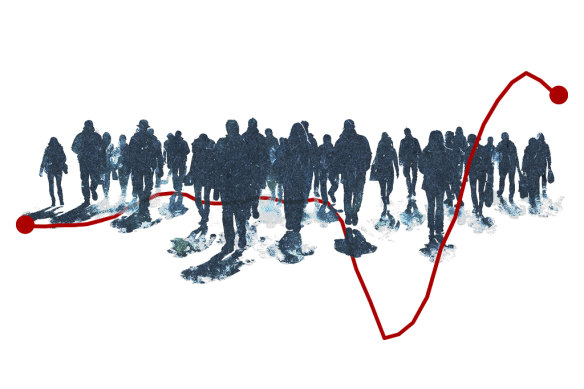This was published 6 months ago
Albanese under fire as migrant intake blows forecasts
By Natassia Chrysanthos and Shane Wright
Australia’s migrant intake will exceed 400,000 for the last financial year, blowing the federal government’s chances of meeting its target as Opposition Leader Peter Dutton condemned Prime Minister Anthony Albanese for failing to manage population growth during a housing crisis.
Figures published by the Australian Bureau of Statistics on Thursday reveal there was a net increase of 388,000 overseas migrants in the first nine months of 2023-24 – just 7000 shy of the government’s 12-month forecast for 395,000 people.

Overseas migration is still above the Albanese government’s targets.Credit:
It guarantees the Albanese government will not meet its migration target – which was already revised up from predictions of 315,000 in last May’s budget and 375,000 in last December’s update – even as surging population growth has started to slow.
The latest blowout of numbers will fuel further attacks from the Coalition, which has already made migration core to its campaign at the next election. Dutton seized on the data within hours of its release and linked it to cost-of-living concerns.
“This is why Australians can’t afford to buy a home, it’s why the rents have gone through the roof and it’s why we find ourselves in a position that we do today with people living without secure accommodation,” Dutton said.
Workplace Minister Murray Watt emphasised that migration had slowed throughout the year and would continue to do so as immigration policies came into effect.
“We recognise that we need to make sure that the numbers of migrants that we have coming to Australia is sustainable, and that’s exactly why we’ve taken a range of actions to bring that number down,” he said.
“We’re starting to see the results of that. The numbers that came out today are actually from March, they’re a little bit lagging. And of course, a number of the measures that we’ve taken took effect after March, so I would expect that we’d see that number fall further.”
The government has promised to halve migration in two years, from a record high of 528,000 in 2022-23, when borders reopened after the pandemic, to 260,000 by 2024-25. The Coalition pledged to drive that down to 160,000, alarming business owners who fear worker shortages.
The latest data shows migration keeps slowing: Australia added 133,800 overseas migrants in the 2024 March quarter, which was 32,000 people fewer than in March the year before. The 12-month rolling total of 509,750 migrants continues a downward trend as tightening measures, such as cutting student visa grant rates, have been gradually implemented.
But it is not being reduced at the rate the federal government anticipated. Former immigration official Abul Rizvi said there had been a large influx of international students in February, while working-holiday makers and people on visitor visas who changed their status also drove up the numbers.
“The March quarter of 2024 was surprisingly strong, particularly because of students. The June quarter will be weaker, but not weak enough to get to the number the government wants,” he said.
The Centre for Population, which is part of the federal treasury, also noted that there had been low departure rates. “[Net overseas migration] remains elevated, with arrivals still high despite some recent moderation, and departures remaining low,” it said.
“Low departures are due to both the relatively recent arrival of many temporary migrants and many onshore migrants seeking to extend their stay by applying for further visas.”
A government spokesman said Thursday’s numbers didn’t reflect key elements of its migration strategy that have come in after March, such as higher international student visa fees and tougher English language requirements.
But the Coalition pointed to comments made by then-Home Affairs Minister Clare O’Neil in April, when she was confident that Labor could achieve its since-revised forecast of 375,000. “The numbers will come out, but the indications are yes, that we will hit that target,” she said at the time.
The opposition also highlighted Albanese’s remarks from December, when he said: “Treasury forecasts show that migration is expected to decline substantially over the coming financial year.”
Of the 509,750 net overseas migrants who arrived in the 12 months to March 2024, 168,148 went to NSW while 151,740 moved to Victoria. Queensland absorbed 82,794 while another 64,902 went to Western Australia.
The figures revealed Australia’s total population climbed beyond 27 million through the first three months of the year. But the rate of population growth is slowing, in line with the drop-off in migration.
KPMG director of demographics and urban economics, Terry Rawnsley, said it appeared population growth had peaked. “Population growth is expected to continue to fall over the coming year as international migration continues to ease, while the weak birth rates continues to raise concerns regarding the long-term demographic outlook for Australia,” he said.
Nationally, the population grew by 2.3 per cent over the past 12 months after peaking at 2.6 per cent in the September quarter. Victoria added the most residents of any state, taking its population to almost 7 million, while NSW is now home to 8.5 million residents.
Cut through the noise of federal politics with news, views and expert analysis. Subscribers can sign up to our weekly Inside Politics newsletter.